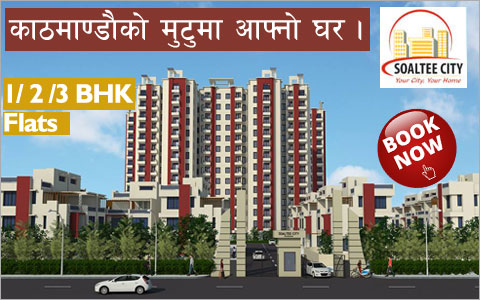National News

The government’s Capital Gains Tax (CGT) collection from land transactions jumped 68 percent in the last fiscal year.
The collection stood at Rs2.07 billion in 2015-16, up from previous year’s Rs1.23 billion, according to the Department of Land Reform and Management.The Kathmandu Valley, where the value of land is higher compared to other locations, accounted for three-fourths of the total collection at Rs1.49 billion—up 60 percent year-on-year.
As for district-wise collection, Kathmandu contributed the most (Rs1.01 billion). Lalitpur saw its CGT collection double to Rs329.39 million, while Bhaktapur posted a growth of 42 percent to Rs150.70 million.
Last fiscal year, the government collected Rs11.90 billion in land registration revenues, up from the previous year’s Rs10.88 billion.Subhash Ghimire, an official of property agent The Realtors, said land prices have gone up multi-fold over the past year, with Lalitpur witnessing a significant rise in the prices. “A rise in house building following last year’s earthquake and lack of alternative investment sectors could have contributed to the rise in land prices,” he said, adding people are also buying land for investment purposes.
Properties Nepal, another real estate firm based in the Bhairahawa-Butwal area, said land prices have almost doubled there. “Construction of an international airport in Bhairahawa, highway expansion and an rising immigration from rural areas contributed to the rise in land transactions and prices,” said Suraj Tandon, proprietor of the company.
Banks and Financial Institutions’ (BFIs) liberal real estate lending policy also catalysed property transactions. The BFIs’ realty lending stood at Rs242.63 billion (Rs138.62 billion personal home loans and Rs104.01 billion real estate loan) as of the 11th month of 2015-16, according to the Nepal Rastra Bank (NRB).In 2014-15, the BFIs had issued Rs118.86 billion in personal home loans and Rs85.67 billion in real estate loans.
source:the kathmandu post,20 august 2016
- 9th Nepal Buildcon International Expo 2024
- Real Estate Expo 2023
- NRB raises housing loan limit to encourage home constructions
- Nepal Rastra Bank (NRB) Monetary Policy 2080-2081
- New Price of Land in Kathmandu Metropolitan City, Nepal
- Capital Gains Tax Rate on Real Estate Transactions in Nepal 2080-81 ( 2023/24 )
- Kathmandu metropolis implements free parking policy for commercial buildings and hospitals

![[X]](https://www.housingnepal.com/images/popup-close-button.png)







































































































































































































































































































































































































 Facebook
Facebook
 Delicious
Delicious
 Digg
Digg
 Reddit
Reddit
 Stumble Upon
Stumble Upon









